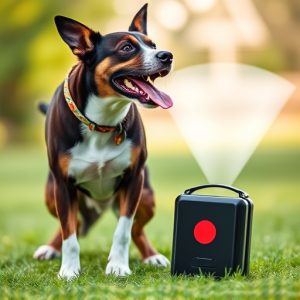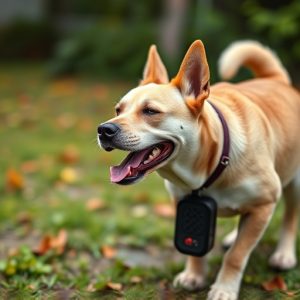Handheld Dog Deterrents: Training, Safety, and Effective Carrying Methods
Dogs' unique behaviors require specialized training tools like handheld ultrasonic repellents,…….
Dogs' unique behaviors require specialized training tools like handheld ultrasonic repellents, which emit high-frequency sounds humans can't hear but dogs find unpleasant. These safe, non-physical methods are effective for various tasks, from preventing table access to stopping barking or jumping. Carrying options include belt clips, pockets, and hook-and-loop fasteners, while adjustable frequency settings allow adaptability. Consistent usage alongside positive reinforcement is crucial for effectiveness. Secure carrying methods prevent accidental drops that could startle or harm dogs. Specialized pouches, lanyards, and built-in cases offer convenient access during training or outdoor activities, emphasizing the importance of Handheld Dog Deterrent Carrying Methods for responsible pet ownership.
Unleash the power of positive training with an innovative approach to dog behavior management—ultrasonic repel gear. This comprehensive guide explores how understanding canine instincts can revolutionize your training routine. From the science behind ultrasonic deterrents to practical tips on handheld devices, you’ll discover safe, effective techniques for addressing unwanted behaviors. Learn optimal training methods and efficient carrying methods for these tools, ensuring a harmonious partnership with your furry friend.
- Understanding Dog Behavior and Ultrasonic Repellents
- Types of Handheld Dog Deterrent Devices
- Safe and Effective Use of Ultrasonic Gear
- Training Techniques for Best Results
- Carrying Methods for Handheld Dog Deterrents
Understanding Dog Behavior and Ultrasonic Repellents
Dogs, like humans, have unique behaviors and responses to their environment. Understanding your dog’s behavior is crucial when introducing training methods such as ultrasonic repellents. These devices emit high-frequency sound waves that are inaudible to dogs but can be effective in deterring them from certain areas or behaviors. By recognizing triggers and cues, owners can use handheld dog deterrents more effectively.
Ultrasonic repellents are one of the many carrying methods for dog training gear. They offer a safe, non-physical way to train pets, making them popular among responsible dog owners. This technology is particularly useful in various scenarios, such as keeping dogs away from tables or preventing unwanted behaviors like barking or jumping. Effective use relies on consistent application and pairing the repellent with positive reinforcement training methods.
Types of Handheld Dog Deterrent Devices
Handheld dog deterrent devices come in various forms, each employing different technologies and carrying methods to suit diverse training needs. One popular type is the ultrasonic repellent, which emits high-frequency sound waves that are unpleasant to dogs but harmless to humans. These devices are convenient for on-the-go training sessions, as they allow you to correct unwanted behaviors without physical contact. They often come in compact, lightweight designs, making them easy to carry during walks or travel.
Another category is the spray-based deterrent, utilizing either air or liquid sprays to startle dogs and discourage certain actions. These are typically triggered by motion sensors or remote control, offering a hands-free approach. While they may be effective for specific issues like jumping up or barking, they require careful handling to avoid mistaking pet behaviors for real threats. Different carrying methods, such as belt clips, pockets, or hook-and-loop fasteners, further enhance the convenience and accessibility of these devices during training sessions.
Safe and Effective Use of Ultrasonic Gear
When using ultrasonic gear for dog training, safety and effectiveness are paramount. These devices emit high-frequency sound waves that are inaudible to humans but can deter dogs from unwanted behaviors like barking or chewing. To ensure safety, always check that the device is designed specifically for canine use and operates within safe frequency ranges. Avoid any products claiming to be “ultrasonic” without clear specifications, as some human-oriented devices may emit harmful sounds.
Effective use involves understanding your dog’s triggers and behavior patterns. Position the handheld dog deterrent in areas where problematic behaviors occur, such as near entry points or favorite chewing spots. Regular, consistent usage is key; dogs respond best to routine. Remember that these tools should never be used as a sole training method but rather in conjunction with positive reinforcement to reinforce desired behaviors. Opt for devices that offer different frequency settings for versatility and adjust the settings based on your dog’s response.
Training Techniques for Best Results
When training a dog using ultrasonic repellent gear, consistency and patience are key. Start by introducing the device as a positive experience—a novel toy or treat-dispensing tool can help ease any initial anxiety. Gradually expose your dog to the sound at close range, rewarding calm behavior with treats or praise. Over time, increase the distance between you and your dog while emitting the ultrasonic signal, reinforcing quiet behavior at each increment.
For best results, practice regular short training sessions rather than long ones. Always use positive reinforcement methods, as negative reinforcement can create fear or aggression. When using a handheld dog deterrent, ensure you employ safe carrying methods—a secure, comfortable grip prevents accidental drops that could startle or harm your pet.
Carrying Methods for Handheld Dog Deterrents
When it comes to carrying a handheld dog deterrent, there are several effective methods to consider, each tailored to different preferences and situations. One popular approach is the use of a specialized pouch or holster designed specifically for this purpose. These accessories allow for secure storage and easy access to the device, ensuring it’s always handy when needed. They come in various styles, from simple fabric pouches to robust leather holsters, catering to both functional and aesthetic preferences.
For those who prefer hands-free carrying, a lanyard or strap can be attached to the deterrent, allowing the owner to wear it around their neck or wrist. This method is particularly convenient for walks in public spaces, as it keeps both hands free while still providing quick access to the device when required. Additionally, some deterrents come with built-in carrying cases or clips, offering a hassle-free way to transport them during training sessions or outdoor adventures.
When utilizing handheld dog deterrent devices, proper training and carrying methods are key to ensuring their effectiveness. By understanding your dog’s behavior and employing strategic training techniques, you can maximize the benefits of ultrasonic gear. Remember, a secure and comfortable carrying method for these devices is essential for both safety and convenience during walks or outdoor activities. With dedication and the right approach, you can train your canine companion to respond positively to handheld dog deterrents, creating a harmonious experience for both of you.


